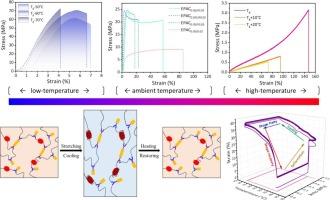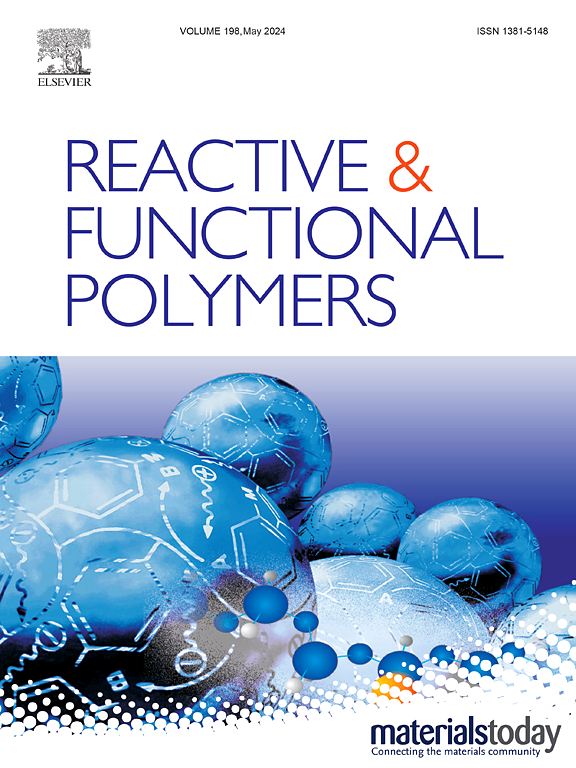Rubber-assisted and modulated epoxy topological network for developing fatigue-resistant, high-strain-cycle high performance shape memory polymer composites
IF 4.5
3区 工程技术
Q1 CHEMISTRY, APPLIED
引用次数: 0
Abstract
High performance shape memory polymer (HPSMP) has a wide range of application such as smart device, smart mold. In this study, we designed a rigid-flexible shape memory epoxy with flexible chain segment as the main chain and rigid benzene ring as the side group. Meanwhile, carboxyl-terminated nitrile butadiene rubber (CTBN) was accessed into the epoxy main chain as a fatigue-resistant functional filler. The results showed that the flexible backbone plays a major role in improving the ductility. The superior fatigue-resistant shape memory cycling performance was synergistically achieved by modulating the epoxy topological network through altering the disulfide cross-linker prompted by CTBN, and the materials exhibited good high and low-temperature resistant mechanical properties. Comparatively, it is found that disulfide bonding can significantly improve the tensile property and thermal stability for epoxy. The synergistic effect between the elastic chain segments in CTBN and the flexible backbone achieves excellent shape recovery ratio. Therefore, the rational structural design provides an effective way to develop HPSMP, which can expand the application areas for HPSMP.

用于开发抗疲劳、高应变循环高性能形状记忆聚合物复合材料的橡胶辅助和调制环氧拓扑网络
高性能形状记忆聚合物(HPSMP)在智能设备、智能模具等领域有着广泛的应用。在这项研究中,我们设计了一种以柔性链段为主链、刚性苯环为侧基的刚柔结合型形状记忆环氧树脂。同时,在环氧主链中加入了羧基封端丁腈橡胶(CTBN)作为抗疲劳功能填料。结果表明,柔性主链在提高延展性方面发挥了重要作用。通过改变 CTBN 促成的二硫化物交联剂来调节环氧拓扑网络,协同实现了优异的抗疲劳形状记忆循环性能,材料表现出良好的耐高温和耐低温机械性能。比较研究发现,二硫键能显著改善环氧树脂的拉伸性能和热稳定性。CTBN 中的弹性链段与柔性骨架之间的协同效应实现了优异的形状恢复比。因此,合理的结构设计为开发 HPSMP 提供了一条有效途径,可拓展 HPSMP 的应用领域。
本文章由计算机程序翻译,如有差异,请以英文原文为准。
求助全文
约1分钟内获得全文
求助全文
来源期刊

Reactive & Functional Polymers
工程技术-高分子科学
CiteScore
8.90
自引率
5.90%
发文量
259
审稿时长
27 days
期刊介绍:
Reactive & Functional Polymers provides a forum to disseminate original ideas, concepts and developments in the science and technology of polymers with functional groups, which impart specific chemical reactivity or physical, chemical, structural, biological, and pharmacological functionality. The scope covers organic polymers, acting for instance as reagents, catalysts, templates, ion-exchangers, selective sorbents, chelating or antimicrobial agents, drug carriers, sensors, membranes, and hydrogels. This also includes reactive cross-linkable prepolymers and high-performance thermosetting polymers, natural or degradable polymers, conducting polymers, and porous polymers.
Original research articles must contain thorough molecular and material characterization data on synthesis of the above polymers in combination with their applications. Applications include but are not limited to catalysis, water or effluent treatment, separations and recovery, electronics and information storage, energy conversion, encapsulation, or adhesion.
 求助内容:
求助内容: 应助结果提醒方式:
应助结果提醒方式:


